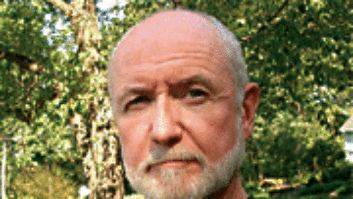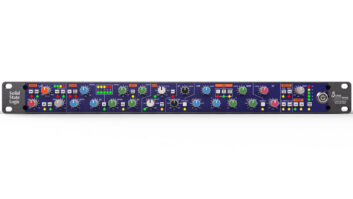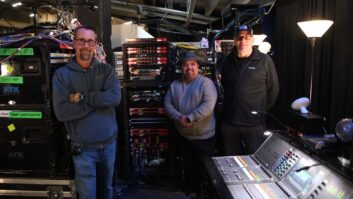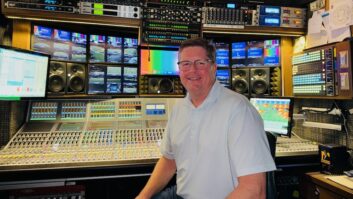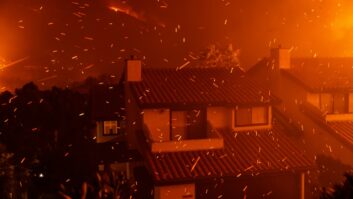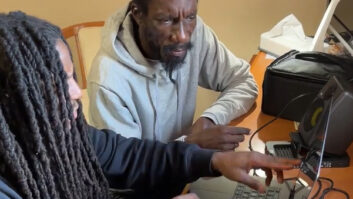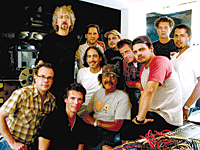

Los Super Seven is more an idea than an actual band. It’s a genre-busting celebration of Southwestern and Latin music, from rootsy tejano kickers to heart-rending ballads to primal rock ‘n’ roll to varying shades of blues. Over the course of three extraordinary albums — the most recent, Heard It on the X, was just released by Telarc — creator/co- producer Dan Goodman has assembled one sterling cast of musicians after another to explore different facets of the many styles found in the region.
The Freddy Fender sessions: Bottom, L-R: Paul Niehaus, Charlie Sexton, Dan Goodman, Freddy Fender and Martin Wenk. Top, from left: Rick Clark, Joey Burns, Max Bacha, John Convertino, Rick Trevino and Jacob Valenzuela
The original Los Super Seven album in 1998 brought together David Hidalgo and Cesar Rosas from Los Lobos, Tex-Mex accordion great Flaco Jimenez, his Texas Tornados bandmate Freddy Fender, country singer Rick Trevino, tejano star Rubén Ramos, Joe Ely and a fine cast of supporting players for an album dominated by traditional Mexican folk songs and a lone English-language standout: Ely’s version of Woody Guthrie’s “Plane Wreck At Los Gatos (Deportee).” The second album, Canto, released in 2001, had a more Latin/South American feeling, with a number of new contributors — including Brazilian singer Caetano Veloso, The Mavericks’ Raul Malo and Peruvian vocalist Susana Baca — joining the Los Lobos gang and others on an extremely diverse set. Los Lobos’ Steve Berlin produced both albums; Dave McNair engineered.
“It’s been a lot of fun having a different cast of characters each time,” Goodman says. “On the first album, we put together Texas artists along with Los Lobos, who are from East L.A., and mined the cultural link between them. And the link was the border, so the first album started out as a Texas-meets-East L.A. thing. The second record we wanted to explore Latin roots music in a pan-Latin context — more of a world music approach. This time around, for Heard It on the X, it was a return to the border, but not in a purely Latin context. It’s more Texas-influenced, mostly English and [encompassing] this fascination we all have with border radio.”
Indeed, “the X” is the nickname given to numerous American pirate radio stations that sprang up just across the Mexican border beginning in the 1930s and blasted an incredible array of great music into Texas and across the Southwest U.S. through the ’70s. (All Mexican stations’ call letters begin with an X.) Adventurous DJs, including the legendary Wolfman Jack (nee Bob Smith), who got his start on a pirate station in the Chihuahuan desert, thought nothing of playing Howlin’ Wolf alongside Hank Williams, Bobby “Blue” Bland, Buddy Holly and Tex-Mex sensation Lydia Mendoza. It was all soulful music, no matter what the context, and it influenced generations of musicians across the Southwest, who picked up on the righteous eclecticism of “the X” as they came up through the ranks themselves.
From left: Johnny Contreras, Joey Burns and Adolf Ortiz at Jack Rock’s treefort studios in Austin
Heard It on the X embraces that spirit even more than previous Los Super Seven discs. There are a few holdovers from previous outings, including Fender, Ely, Jimenez, Malo, Trevino and Ramos. But much of the cast this time is new: The distinctive singers include Texas R&B stalwart Delbert McClinton, Rodney Crowell, John Hiatt, Lyle Lovett and Clarence “Gatemouth” Brown. Fine guitarist Charlie Sexton contributed heavily to the album’s instrumental sound (and co-produced), as did Joey Burns and John Covertino of hip Tucson band Calexico and ex-Tin Machine drummer Hunt Sales. Cameos by such notables as steel guitar wiz Lloyd Maines and former Merle Haggard guitarist Redd Volkaert also spice up the set, which runs the gamut from horn-driven Mexican tunes, early rockers by Buddy Holly and Bobby Fuller, tracks by the influential Texan Doug Sahm and blues songs by Willie Dixon and Texan Blind Lemon Jefferson. The title track? It’s by the Texas hard rock band ZZ Top, of all people.
“We wanted the material to have some connection to the era and sensibility of border radio,” notes Rick Clark, who co-produced the album (with Goodman and Sexton), selected nearly all of the songs and played on the album. Clark continues, “We wanted to celebrate the universality of the Texas border experience, putting pictures in new frames as much as possible. Like with ‘Heard It on the X,’ the idea wasn’t just to use a ZZ Top song. Thematically, it seemed perfect, but in my head, I heard it as almost tribally percussive. I wasn’t married at all to the original riff the song was built on. Charlie picked up on that idea, adding exciting production arrangement touches.”
Besides being a longtime contributor to Mix (and our current Nashville editor), Clark has developed a solid reputation as a music historian, with extensive knowledge of obscure (and popular) Americana and a knack for finding cool songs for projects. He unearthed a number of the songs on the first two Los Super Seven albums, and for the past several years, he’s compiled amazing CDs of Southern tunes of every genre for the Oxford American magazine’s annual music issue. He’s also done music consultation for films.
“Rick is the best,” Goodman says. “He knows what’s out there and knows how to find great obscure material that always manages to strengthen our concepts. Rick and I were strongly committed to the songs we had chosen and our conceptual idea, and we set out to cast the music with artists we felt would deliver stellar performances.”
Denny Freeman has played with Stevie Ray and Jimmie Vaughan, singer Angela Strehli and more.
Clark’s search for material took many months, considerable travel and countless hours of listening. “I went out and gathered everything from 1906 Edison cylinder recordings of mariachi bands to cowboy hollers, to free jazz and psychedelic garage music,” he says. “I listened to hundreds of songs and then I’d sort of narrow it down and narrow it down, and then bring the prime candidates to Dan [Goodman]. Then we’d debate the merits of various songs in listening sessions. It was an impassioned give and take.
“I went to the LBJ [Lyndon Baines Johnson] library in Austin and talked to all sorts of record collectors. One song I came away with from that [Austin] trip was ‘Talk to Me’ by Sunny & The Sunliners. Three or four people, out of the blue and disconnected from each other, suggested that song, so I knew I was onto something. And it’s not available anywhere that I know of on CD. It’s from the late ’50s originally. It was one of the first Hispanic pop records to make the Billboard charts. Little Willie John did a version, too.” McClinton sings it on the new album as if the song was his.
Other pairings were equally serendipitous: Who better to tackle the old Bob Wills Western swing tune, “My Window Faces the South,” than the modern heir to that sound, Lyle Lovett? Concerning Ely’s performance of Bobby Fuller’s “Let Her Dance,” Clark states, “It seemed totally right for him — it’s got that weird Buddy Holly meets Del Shannon meets ‘La Bamba’ kind of thing. We then found out that Joe played it in bands when he was younger.” And the choice of Brown to sing the closing number, “See That My Grave Is Kept Clean,” takes on added poignancy because the great bluesman has been diagnosed with terminal cancer. “We had chosen that song for Gate a good year-and-a-half before we got the news,” Clark says. “The great thing about that track, though, is that it’s not a long-faced thing. It’s actually very upbeat the way he plays it. It’s a nice note to end on.”
Co-producer Dan Goodman, “Gatemouth” Brown, and co-producers Charlie Sexton and Rick Clark
Initial tracking sessions for Heard It on the X took place over a period of 10 days in September 2004 at treefort studios in Austin, with McNair once again engineering. McNair, who lives in Manhattan but is originally from Texas, mostly works as a mastering engineer these days, “but I’ll do one or two recording projects a year, too,” he says. “Treefort is in this guy named Jack Rock’s house and it’s pretty cool. It has a separate control room, but for everything else, you’re in different parts of the house and they have snakes [connecting everything]. It has an Amek console, but we just used it for monitoring. We recorded to Pro Tools|HD and we brought in a lot of preamps and stuff. Jack’s got a lot of cool gear.
“We were usually recording a lot of people live at one time and there wasn’t much isolation, but that doesn’t bother me. I just put some mics up and we captured it. We had the drums in the dining room and then everybody else was in the living room, so it was a little different than a typical studio setup. The drums were slightly isolated, but [the rooms are] totally untreated walls and glass doors, so it goes right through. In the main room, there might be a lot of guys playing acoustic instruments. And I isolated the upright bass as much as I could — it was in a little room we made in the entryway with a makeshift gobo wall. The setup was rarely the same on consecutive tunes, so we were always moving things around. We didn’t really have time to sit there and audition microphones; we were working fast.”
Fortunately, he had some good equipment to work with, both at treefort and for later overdubbing sessions at Ocean Way in Nashville, where he mixed the album on a Neve VR. (There was also some overdub work done at Paragon in Nashville.) “We had all sorts of great analog outboard gear,” he says. “The usual LA-2As and 3As, 1176s. I used a BSS DPR-901 compressor on a lot of the vocals.” Vocal mics included Neumann U47s, Shure SM7s, “and I believe I used an [AKG] C-12 on one of Delbert’s tunes,” McNair says.
West Side Horns let it howl, pictured from left: Al Gomez, Spot Barnett, Luis Bustos
Also, McNair notes, “Jack Rock is a total gearhead and an electronics genius, so treefort has stuff like old [Telefunken] V-76s. He has a whole rack of solid-state Neumanns and the usual Neve and API stuff. He also has these really weird radio station tube mic pre’s that you can still find on eBay for a pretty good price. He’s got like eight of those bad boys and we ended up using them on a lot of stuff, especially guitars. I’m not going to mention the brand name because they’re still out there and they’re cheap and nobody knows about them.” Translation: He wants to buy them so you can’t.
Clark says that engineer McNair is “an absolute jewel. The guy is an incredibly hard worker, he’s totally attuned to what it takes to do audiophile-level recording, but he is also absolutely fearless in breaking rules to get unique sounds. He likes f***ing up drum sounds and vocal sounds, but he does it in a very artful way. It can be subtle things, like distorting Delbert’s voice a little on ‘I Live the Life I Love’ or coming up with these outer space tones that come out of the blue [on ‘Cupido’]. That’s totally McNair. He comes up with touches that make the music stand out in relief in exciting ways.”
This is the first Los Super Seven project without contributions from Los Lobos. In a sense, their “house band” role has been taken over by members of Calexico, another Clark “find” for the project. “The Calexico guys really bring something fresh and different to the album,” he says. “The first time I heard them, I felt an immediate connection with them, and their presence on the record and their involvement, creatively and spiritually, is very significant — not only in what they played, but in the selfless manner in which they approached everything in the studio each day. It was always, ‘How can we make this as special as we know it is?’”
With their relative youth, too, Calexico is, in effect, the next generation of musicians who understand the spirit of border radio. Clark and Goodman also emphasize the importance of Sexton’s standout production contributions on the album; in some ways, he provides the instrumental glue that holds many of the songs together.
“This particular album was personal for me,” Clark says. “Though I didn’t listen to the ‘the X’ when I was growing up in Memphis, I remember very clearly hearing the Top 10 countdown and right next to the Rolling Stones and The Supremes, the DJs would play local bands like The Guillotine, the Box Tops or the Swinging Yo-Yos, and there was this great feeling of regionalism to the music. This is all before the days of radio consultants and corporate radio, when DJs could still play music they dug. So this album [Heard It on the X] is the embodiment of that spirit. Border radio was the ultimate example of musical and cultural synthesis, where all that really mattered was does it sound good? Is it cool?”
Heard It on the X sounds good. And it’s cool. But will radio play it? “I have no idea,” Goodman says with a chuckle. “Rick and I brainstorm on the music we want to make, we get it together and then let the record company worry about getting it on the radio. Maybe some triple-A or Americana stations will pick it up. I have a lot of faith that serious music lovers out there who really keep their ear to the ground will discover it. Regardless, it is a record that we are very proud of.”

All photos by Rick Clark
Redd Volkeart
Click here to hear clips from LSS’s new album, Heard it on the X
